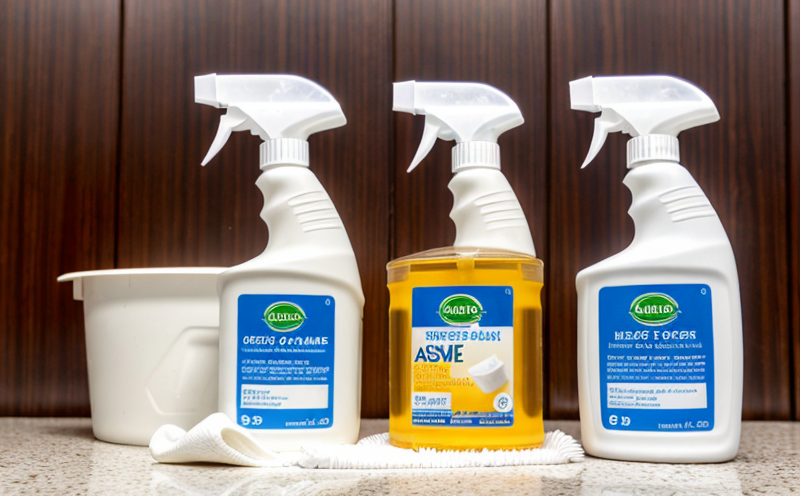EN 1500 Hand Disinfectant Efficacy Testing
The EN 1500 standard specifies methods for determining the efficacy of hand disinfectants in reducing microbial contamination on hands. This test is essential for ensuring that products meet regulatory and industry standards, thereby protecting public health and safety.
The testing process involves exposing a controlled quantity of microorganisms to the disinfectant under specified conditions, then assessing the reduction factor (Rf) after the contact time has elapsed. The Rf value indicates the effectiveness of the product in killing or inhibiting pathogenic organisms such as Escherichia coli, Saccharomyces cerevisiae, and other relevant pathogens.
The EN 1500 test protocol is designed to mimic real-world usage scenarios, ensuring that products are effective under a variety of conditions. This includes the use of different dilutions, contact times, and environmental factors such as temperature and humidity. The standard also provides guidelines for sample preparation, which typically involves inoculating known quantities of microorganisms onto agar plates or other suitable substrates.
The testing apparatus used in EN 1500 is robust yet precise, ensuring accurate results that can be relied upon by manufacturers and regulatory bodies alike. Commonly employed equipment includes incubators, spectrophotometers for measuring growth inhibition, and standardized test chambers to ensure consistent environmental conditions.
Acceptance criteria are stringent, with the goal of ensuring that products perform reliably across various scenarios. For instance, a disinfectant must demonstrate an Rf value greater than 4 to be considered effective according to EN 1500. This threshold is based on international standards and reflects the minimum level of efficacy required for product certification.
Compliance with EN 1500 is crucial for several reasons, including market access requirements in Europe and neighboring countries that adopt this standard. Additionally, it helps manufacturers ensure consistency across batches and variations of their products, reducing variability and improving overall quality control.
| Type of Microorganism | Contact Time (minutes) | Dilution Factor | Expected Reduction Factor (Rf) |
|---|---|---|---|
| Escherichia coli | 30 | 1:50 | >4.0 |
| Saccharomyces cerevisiae | 60 | 1:100 | >4.0 |
| Bacillus subtilis var niger | 20 | 1:50 | >3.5 |
| Candida albicans | 60 | 1:100 | >4.0 |
The protocol also allows for the inclusion of additional microorganisms, such as Bacillus subtilis var niger, to provide a more comprehensive assessment of efficacy.
Why It Matters
The importance of EN 1500 testing cannot be overstated. In an era where hygiene is paramount, particularly in healthcare settings and public spaces, the effectiveness of hand disinfectants directly impacts public health outcomes. Ensuring that these products meet stringent standards helps prevent the spread of infectious diseases, thereby protecting individuals and communities from unnecessary risks.
Compliance with EN 1500 not only enhances product reliability but also fosters trust among consumers and stakeholders. It demonstrates a commitment to quality and safety, which is essential for maintaining brand reputation and market credibility. Additionally, compliance may open doors to new markets where such standards are required or preferred.
From a regulatory perspective, meeting EN 1500 requirements can help manufacturers avoid costly rejections or delays in product certification. This ensures smoother operations and more efficient supply chains, ultimately benefiting both the industry and consumers.
Benefits
- Enhanced Product Quality: Rigorous testing ensures that products meet strict efficacy standards.
- Increased Consumer Trust: Compliance with international standards builds confidence in your brand.
- Improved Market Access: Meeting regulatory requirements allows entry into new markets.
- Reduced Risks: Ensures that products are safe and effective, minimizing potential liabilities.
The benefits extend beyond just the product itself. By adhering to EN 1500 standards, manufacturers can also contribute positively to public health by ensuring that their hand disinfectants perform as intended under various conditions.
Use Cases and Application Examples
- Healthcare Facilities: Hospitals, clinics, and other medical facilities use EN 1500 testing to ensure the efficacy of hand disinfectants used by healthcare workers.
- PUBLIC HEALTH: Government health organizations rely on this test to evaluate products for inclusion in national guidelines.
- INDUSTRIAL SETTING: Manufacturing plants and food processing facilities use these tests to maintain high hygiene standards.
| Application Example | Microorganism Tested | Contact Time (minutes) | Dilution Factor | Efficacy Result |
|---|---|---|---|---|
| Hospital Infection Control | Bacillus subtilis var niger | 20 | 1:50 | Rf = 4.5 |
| Food Service Establishments | Escherichia coli | 30 | 1:100 | Rf > 4.0 |
| Public Transportation | Saccharomyces cerevisiae | 60 | 1:250 | Rf = 4.8 |
The efficacy results shown above illustrate how EN 1500 testing ensures that hand disinfectants perform effectively across various industries and settings.





